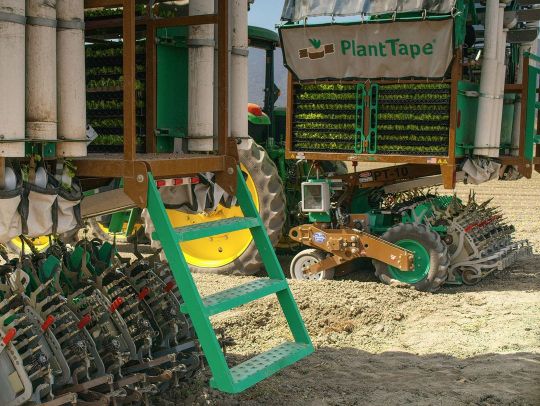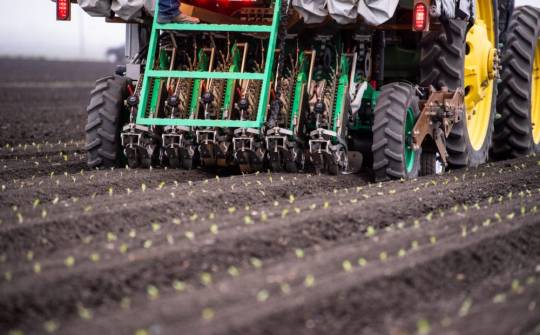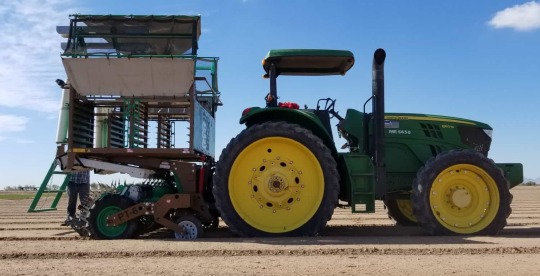Text
What’s new in tomato farming technology?
Tomatoes are one of the most economically significant crops in the world. It’s estimated that 188M tomatoes were produced worldwide in 2018.
Tomato growers, on the other hand, are dealing with a plethora of difficulties, including climate-related pest and disease outbreaks, manpower shortages, and dry borewells, to mention a few.
As a result, millions of tons of tomatoes are wasted each year.
Growers now take advantage of technology to grow tomatoes more efficiently through task-tracking systems, drones, and state-of-the-art tomato transplanters.
In this post, we’ll strive to keep our tomato growers up to date on the latest technology on the market, as well as what they might expect in the future.

Sensors and satellites
To visualize the growth status of tomatoes, smart farming firms provide sensors and satellite pictures to tomato growers. Growers can also use remote sensors (sensors and satellites) to help with vegetation surveys, weather station data, soil samples, and other tasks.
Artificial intelligence
There are also several systems on the market that use artificial intelligence (AI) that is based on grower expertise. An AI platform can help you stabilize crops and minimize production costs while practicing environmentally friendly farming, whether you’re an expert or a novice at growing tomatoes.
Tomato planters
Tomato growers have benefited greatly from the invention of tomato planter machines. Nowadays, the market is flooded with a wide range of transplanters. Some agricultural technology companies claim to be able to reduce labor requirements by up to 80%, provide more exact plant spacing, and provide healthier root benefits.
Future agtech developments
Tomato producers should anticipate that as time passes, more and more technology will become available. Tomato growers in the United Kingdom, for example, are partnering with researchers to develop a novel sensor to boost yield.
According to an article published by Horti Daily, the goal of this study is to gain a better understanding of the water balance within plants in order to improve on-farm efficiency, reduce tomato losses, and extend the shelf life of the crop.
0 notes
Text
PlantTape helps growers improve their production and productivity without extra labor
PlantTape revolutionizes transplanting and greenhouse operations. The advantages of our automated transplanting system over other alternatives are stark.
Other types of transplanter plant ~1 acre per hour with a 15-person crew. PlantTape plants 2-7 acres per hour (depending on crop type) with a 3-person crew, tractor driver included.
Other plant nursery systems allow 750 seedlings per square meter of floor space. PlantTape enables plant densities of 2500 plants per square meter of floor space (said in other terms, a million seedlings per 5,000 square feet).
That’s a 300% increase in greenhouse efficiency–BEFORE factoring in a shorter growing cycle.

PlantTape seedlings can be transplanted, through their seedling planter, at any point in their growing cycle, meaning that greenhouses can have more growing cycles.
Faster transplanting, higher greenhouse production, lower labor costs: the benefits of the PlantTape system accrue rapidly, allowing growers to run leaner, more precise, and more profitable growing operations.
#transplanting#transplant#transplanter#vegetable transplanter#tomato transplanter#hemp transplanter#planter#planter machines
0 notes
Text
Transplanters for hemp
Hemp can be transplanted in the same way as other agricultural crops like onions, lettuce, and cabbage can. Hemp transplanting necessitates meticulous planning and attention to detail.
Modern hemp transplanters increase crop yield, increase transplanting speed, and significantly lower transplanting labor costs for hemp growers.

Transplanters in the market
Hemp planters have evolved. Depending on your needs and budget, they can either be mechanical or automated, and they require fewer people to work on the ground.
Most transplanters are able to accurately place the seedlings in the ground, hydrate them, and firmly pack the dirt around them.
The best hemp transplanters can eliminate slippage, maintain regular plant-to-plant spacing, and pack seedlings more tightly.
One of the most useful aspects of modern transplanters is the capacity to plant hemp plugs straight up to a height of 22 inches.
Different hemp transplanters are designed to meet the needs of plasticulture, no-till, or other types of hemp agriculture.
Hemp planter machines – the right choice
If you are just starting to grow hemp, or planning to expand your hemp farm, hemp planters are the way to go. But before you purchase a planter, you need to do your research. The right hemp transplanting system can make all the difference to the profitability of your growing operation.
0 notes
Text
What are vegetable transplanters?
Transplanters aren’t exactly a new agricultural technology. The first transplanter was a rice transplanter invented in 1898 by Heigoro Kawano. Transplanters for rice, vegetables, hemp, and other crops have been in widespread use since the early 19th century.
Vegetable transplanters have improved in output, efficiency, accuracy, and ease of use since then.If you’re a novice grower or you want to expand your operations, this article will guide you through the realm of transplanters.

What are transplanters
Transplanters are agricultural machines that can be towed, driven, or self-propelled and allow the planting of seedlings from seed bins.These
vegetable planters are tasked with opening the destination soil, placing the seedling in its proper location, and then closing the soil around it.
Benefits of having vegetable transplanters
Vegetable transplanters are beneficial for several reasons: Automated transplanters can plant anywhere from an acre to 5 acres of vegetables per hour, depending on the specific transplanter and the type of vegetable being transplanted.Some automated transplanting systems need only three people to operate, meaning that planter machines can save vegetable growers up to 80% in labor costs.
What crops can be transplanted
Most common vegetable crops can be transplanted.
Cabbage
Lettuce
Cauliflower
Onions
Garlic
Celery
Chard
Shallots
Spinach
Kale
Leeks
Broccoli
Cilantro
0 notes
Text
Transplanting tomatoes with PlantTape
The PlantTape automated transplanting system is ideal for large-scale tomato agriculture. For tomato growers, PlantTape can cut transplanting labor costs by 80% while increasing crop yield and greenhouse throughput.
PlantTape is based in Salinas, California and services the entire United States and even international countries.

Looking at the performance history of the PlantTape tomato planter machine, we have have arrived at the following reasons why they are at the top of their game:
Speed and productivity
PlantTape’s tomato planter can transplant 5-7 acres of tomatoes with just a crew of 3 including the tractor driver. This is a good consideration for tomato farmers as labor requirements can be reduced by as much as 80%, while crop yields tend to improve due to better precision with seedling placement.
Adaptability
The PlantTape automated tomato transplanter is easy to use, especially in plant-to-plant spacing where you can adjust plant spacing in quarter inch increments. For line-to-line spacing, the transplanter can be reconfigured in the field with simple tools, and can accommodate almost any bed configuration.
Root benefits
Instead of the traditional containerized soil plug that forces the roots into a tight ball, the PlantTape system has the ability to grow tomatoes in an open-bottom plug. This results in the plant to actively grow in a natural root architecture, and to establish well in the soil.
0 notes
Text
Transplanting vegetables with PlantTape
PlantTape—an agricultural technology company— is a turnkey solution for vegetable growers looking to boost efficiency and crop productivity while reducing labor costs involved with transplanting.
Cabbage, lettuce, broccoli, cauliflower, kale, leeks, collards are some of the most common vegetable crops grown with the PlantTape transplanting system.

Vegetable transplanting with PlantTape
PlantTape allows for quick transplanting. Two to five acres of onions, cabbage, broccoli, or other vegetables can be transplanted every hour by a three-person crew (including the tractor driver).
PlantTape reduces vegetable transplanting labor requirements by 80 percent when compared to other transplanting systems that require a 15-person crew, while enhancing transplanting productivity and crop production.
PlantTape's vegetable planter provides for extremely fine plant-to-plant and line-to-line spacing control.
0 notes
Photo

(photo source: PlantTape)
If you're a grower of any scale, you've probably looked into automated transplanters. A company called PlantTape doesn't just sell automated transplanters: they sell automated transplanters that are part of a comprehensive automated transplanting system.
PlantTape, an agricultural technology firm based in California, is quickly becoming the leading transplanting system for growers of vegetables, tomatoes, and hemp.
To learn more about automated transplanter and ag technology, visit the PlantTape website now at http://www.planttape.com/
1 note
·
View note